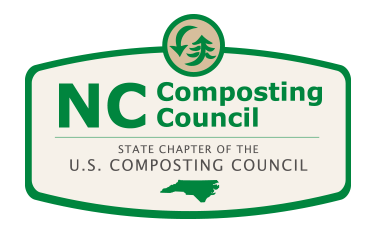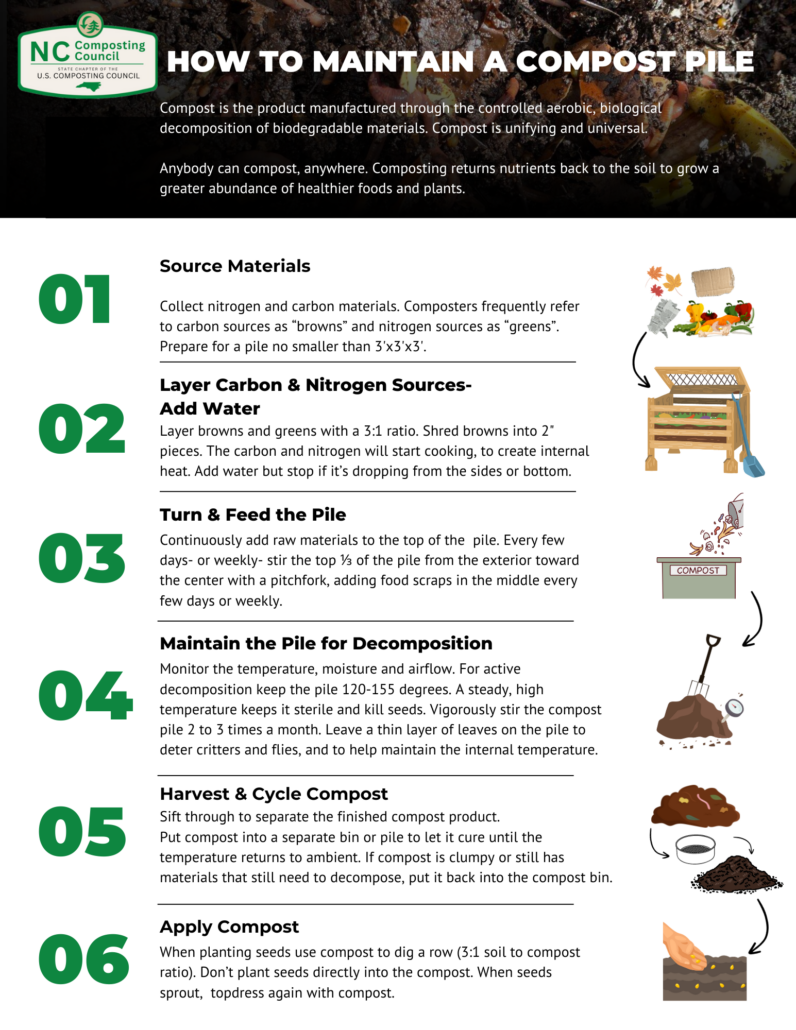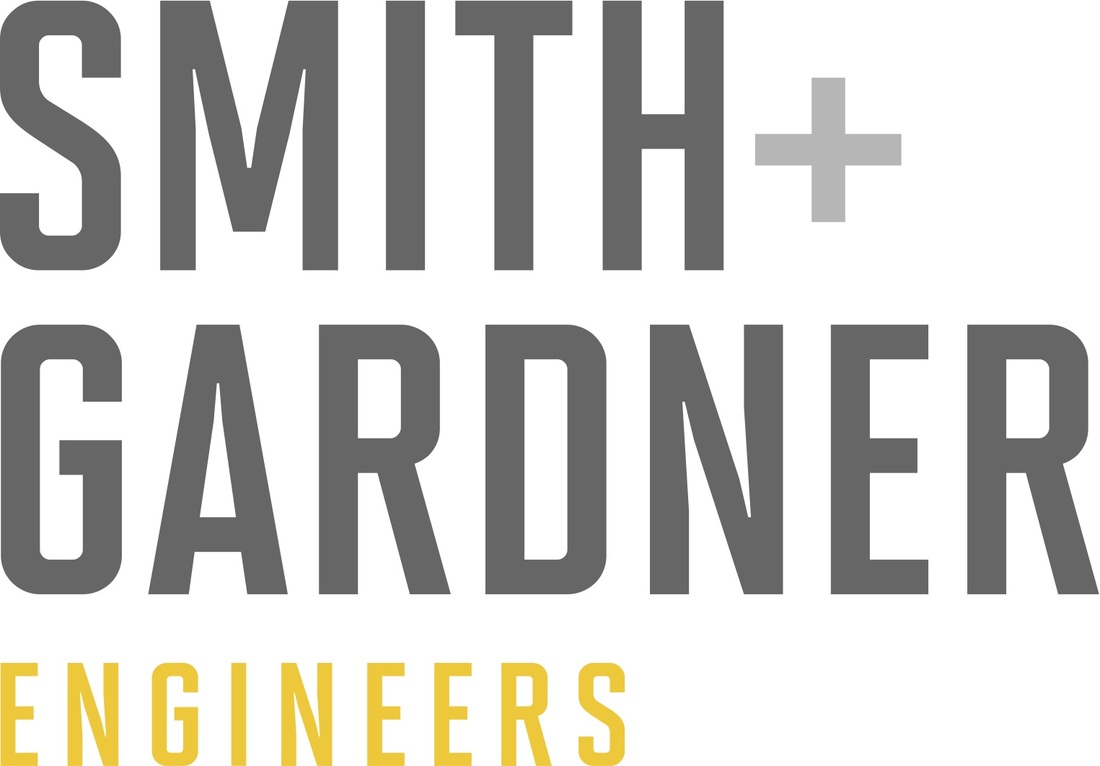Backyard Composting Resources
How to Compost in a Pile
Compost is unifying and universal. Anybody can compost, anywhere. Composting returns nutrients back to the soil to grow a greater abundance of healthier foods and plants.
Compost is the product manufactured through the controlled aerobic, biological decomposition of biodegradable materials. There are different methods and styles of composting, such as backyard composting, vermicomposting, and large-scale composting.
The Fundamentals of Composting
All methods of composting require the maintenance of the following four elements:
- Carbon
- Nitrogen
- Water (Moisture)
- Air (Oxygen)
Getting Started
Collect Carbon & Nitrogen Sources
The combination of carbon and nitrogen in high volumes causes a chemical reaction that produces heat. That hot environment supports thermophilic bacteria, a heat loving bacteria that eats nitrogenous waste. In the words of Craig Coker, “nitrogen is the fuel that burns carbon.” Carbon provides structure and porosity, so there are air pockets even when it’s wet (ideally like a wrung out sponge or around 70-80% moisture).
If your compost pile is too slimy and stinky, it needs more carbon. If it’s cold, there is not a good balance of carbon and nitrogen– or it may be dry. Microbes need a moist environment in order to thrive.Oftentimes when a compost pile is struggling, it is too dry. The goal is to keep it damp (but without dripping water on the sides) and to continuously feed the pile carbon and nitrogen sources. Worms help aerate the pile– providing essential oxygen. Adding holes on the sides, or a tube with holes placed down the middle of the pile is another way to add oxygen to the compost pile.
To start composting, collect nitrogen and carbon materials. Composters frequently refer to carbon sources as “browns” and nitrogen sources as “greens”. Examples of carbon materials include leaves, cardboard, paper towels, newspaper, sawdust (without formaldehyde glues), sticks, etc. Browns added to the compost pile should be dry.
Good sources of nitrogen include yard and kitchen food scraps, coffee grounds, grass clippings, etc. It is best to avoid adding orange peels and other citrus foods to a backyard compost system because of the acidity. Citrus foods are antiseptic, which is not ideal for the bacteria environment within a compost bin.
To collect food scraps, any container with a tight fitting lid works great. A thrifted aluminum steamer pot with a lid works well to collect food scraps in the kitchen. Reusing an ice cream container also works! There are options that can hook underneath a shelf or your countertop so they’re out of sight.
Some people keep their kitchen food scrap bin in the freezer to avoid fruit flies; if it’s a smaller container and emptied every few days then it’s likely not necessary.
Choose a Method of Backyard Composting
Choose a small scale composting system for at home, school or the office.
- Pile System (such as the Earth Machine)
- 3-Tier System
- Hole or Trench System
The Earth Machine system is a concentrated vessel open to the ground, and a great option if composting with limited outdoor space. It is open to the soil, which allows microorganisms from the earth to travel into the compost pile naturally. Tumblers– another common, small backyard system– are not exposed to the soil, which limits the ecosystem. Therefore, we recommend an Earth Machine system for efficient backyard composting. This system can create around 80 gallons of finished compost! The Town of Cary, Wake County, and Orange County also sells the Earth Machine locally in North Carolina.
Keep a chicken wire cylinder next to your backyard composting system to collect leaves for use throughout the year as a carbon source. It is not recommended to use weeds in a backyard composting system. While it is common practice not to include dairy, bones, shrimp shells, fish/meat, etc. in a backyard composting system, if it’s buried deeply into a mature compost pile (to deter critters), then it can be a beneficial source of microbes and calcium.
Setting Up a Compost Pile: Best Practices for Getting Started
Fall is a good time to start to accumulate carbon. Compost piles still get a heat surge during the winter because the heat comes from within when there is a good presence of carbon, nitrogen, and water. Leaves work well because soil dwelling microorganisms are already attached to them. Shredded cardboard and newspaper also work well. Never use office paper or junk mail because they don’t break down easily and chemicals and inks can leach into the compost pile.
The Earth Machine is a fantastic option for backyard composting, because it is compact and enclosed, but also touches the ground. Another option for smaller outdoor spaces is the above-ground tumbler, however we do not recommend using an above-ground system to create a high-quality microbial soil environment. If you have more outdoor space, a three or four pallet system works well. A trench system or even just using a hole in the ground or an above-ground pile also gets the job done!
For a system that touches the ground– like the Earth Machine or a pallet system, select a bare spot– not grassy. TIP: It is great to keep a compost pile where you want to garden, so the finished product can readily be spread over the garden area! It is also smart to keep the compost pile close to a water source, because it is important to maintain the moisture within the pile.
When composting, add carbon and nitrogen at a 2:1 or 3:1 ratio. If backyard composting with food scraps as the primary nitrogen source, the ratio can be mixed closer to 1:1, since food scraps also contain some carbon (but more nitrogen). To start, layer a pile of leaves and twigs on the bottom to create slight aeration. Shred carbon sources to 2” pieces before adding them to the pile. Layer carbon and nitrogen sources. The carbon and nitrogen will start cooking, to create an optimal internal heat. Then just continue to feed it!
Between each layer add water (if it is needed/ not damp) and sprinkle a layer of compost between layers to help accelerate decomposition. It is necessary to add more water in the summertime, when the evaporation rate is high. The more you water it and keep the microbes happy, the better (as long as its not dripping water from the sides).
Raw materials are continuously added to the top of the compost pile, while fixing is happening at the bottom. Overtime, the small system will not fill up because it breaks down to a quarter of its original volume. As it’s compressing, the bottom is where the fixing is happening.
Stir the top ⅓ of the pile from the exterior toward the center with a pitchfork, adding food scraps in the middle every few days or weekly. Vigorously stir the compost pile two to three times a month. Leave a thin layer of carbon (leaves) on the top of backyard composting systems to deter away critters and flies, and to help maintain the internal temperature. Leave the pile alone for a few days, then check the temperature.
Compost Cycle & Application
Use compost when planting seeds- dig a row and place compost first; dig the ditch in with the compost (3:1 soil to compost ratio). Don’t plant directly into the compost. When seeds sprout, topdress again with compost.
If compost is clumpy or still has materials that still need to decompose, put it back into the compost bin. Bones erode and create a bone meal with a high value of calcium. From time to time, it’s ok to include in backyard composting but not overboard. Try not to put in meat.
Frequently Asked Questions
Should I set up my compost pile in the sun or the shade?
Partial shade helps because heat come from within the compost pile. Sunlight can evaporate moisture more than a pile in the shade.
Shaded spots may have plant roots going up into the compost, which can be challenging when harvesting.
There are pros and cons to both, but lean to shade bcause it is so hot and dry in the summertime in North Carolina. Also consider keeping your pile in a place where you can easily access water!
Will my compost pile attract snakes, raccoons or other undesirable creatures?
-
A good balance of carbon and nitrogen will break down thoroughly. Those creatures, like snakes and raccoons, like fresh vegetative materials. They are going to want to paw in where it’s hot. They want things on the surface. Think of it as a soil ecosystem. Bury everything. Make it available for soil dwelling organisms, not creatures up top. If the pile is balanced well, it will break down effectively and quickly. Keep in mind you’re making a soil, and that’s likely going to only attract soil-dwelling organisms.
What extra precautions should be taken if composting in bear country?
-
Make sure you’re composting correctly. Always have a nice layer of brown on top of scraps and the pile; make sure food scraps are buried in the center. Also be sure to keep the compost pile moist.
- Us a structure to keep it contained and help keep critters out.
-
If it’s a probelm for food to decompose in an outside pile, consider using a vermicomposting bin indoors, and then once the pile is more broken down, add it to the outside system.Always keep it moist and browns on top
-
It is essential to compost correctly in bear country, to decrease chances of attracting unwanted critters and creatures.
Should I bake eggshells to make them more brittle before composting?
No, it is not necessary. Eggshells provide good calcium and can easily be broken by hand before added to the pile
Should I screen finished compost?
It is helpful to screen finished compost to separate any materials not yet fully decomposed. Screening is especially helpful when vermicomposting, since it’s wet and clumpy. Consider reusing a window screen or a panning sized screen to separate finished compost from a backyard pile.
My newly set up compost pile is leaking fluids. Can I make compost tea with it?
A wide spectrum of bacteria can live in a compost system. Ones occuring early can break through the cellulosic layer and break carbon bonds. You do not want to put that liquid on your fruits and vegetables. This is leachate.
Make tea out of finished compost- it should look like dirt, smell like and dirt and be cool to the touch.
ILSR Backyard Composting Videos: Available in English & Spanish
Learn to recycle those food scraps and yard trimmings with the Institute for Local Self Reliance (ILSR) home composting basics video series
Click here to add your own text
![]()








